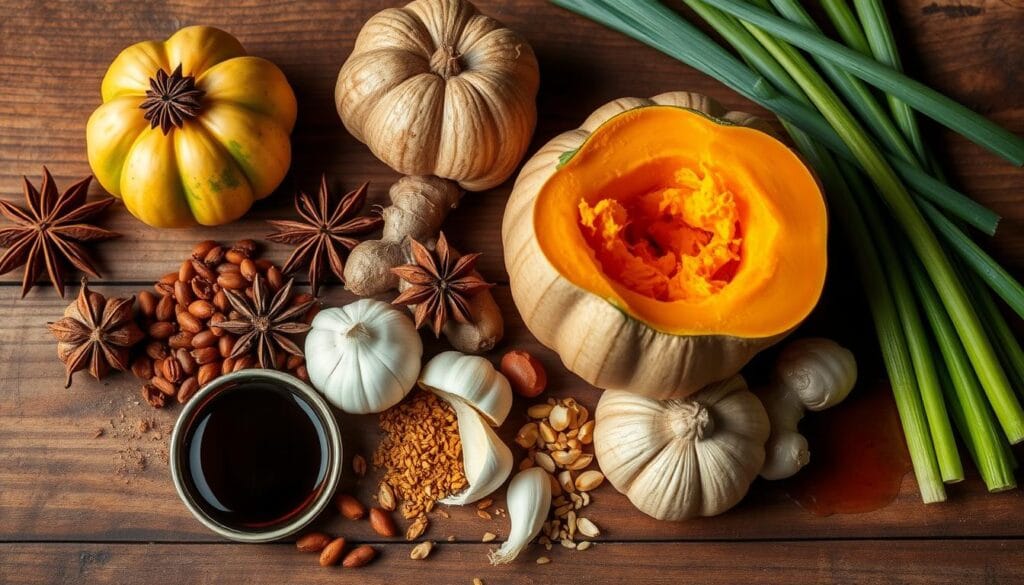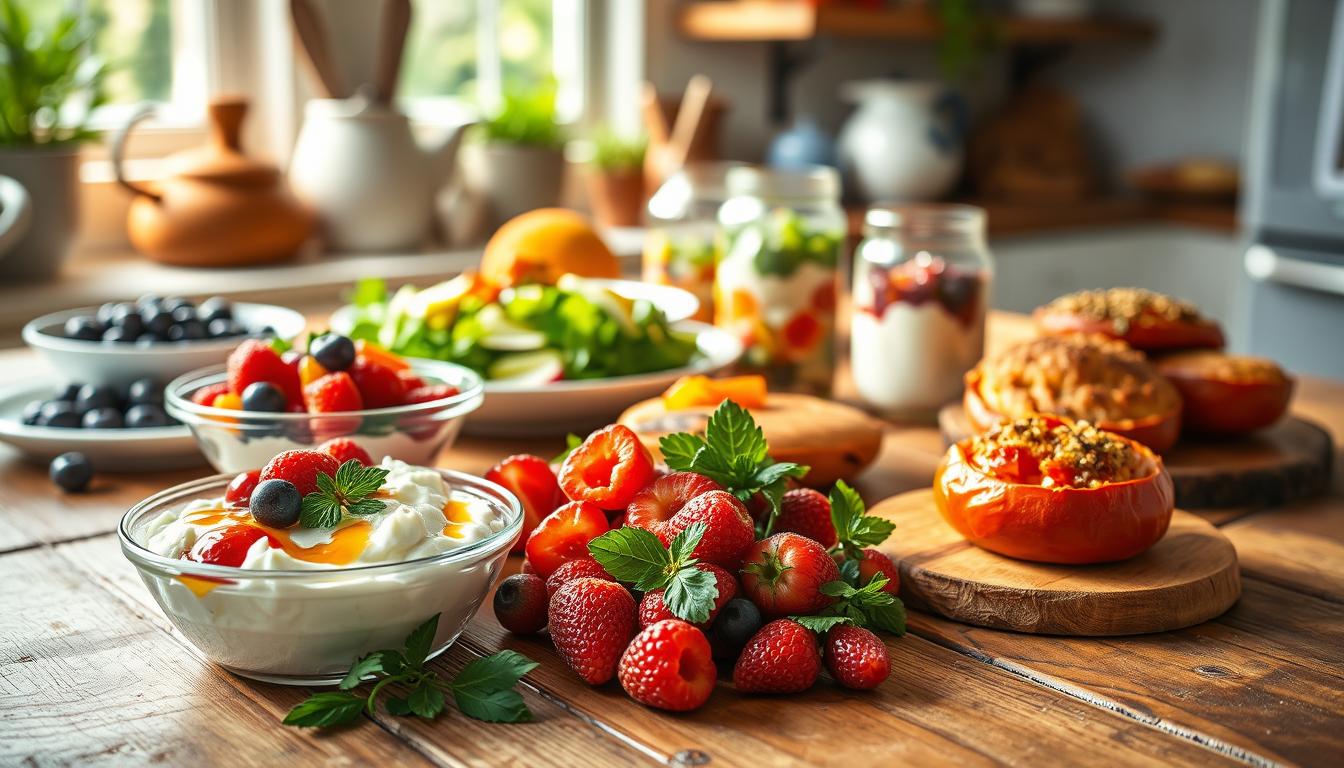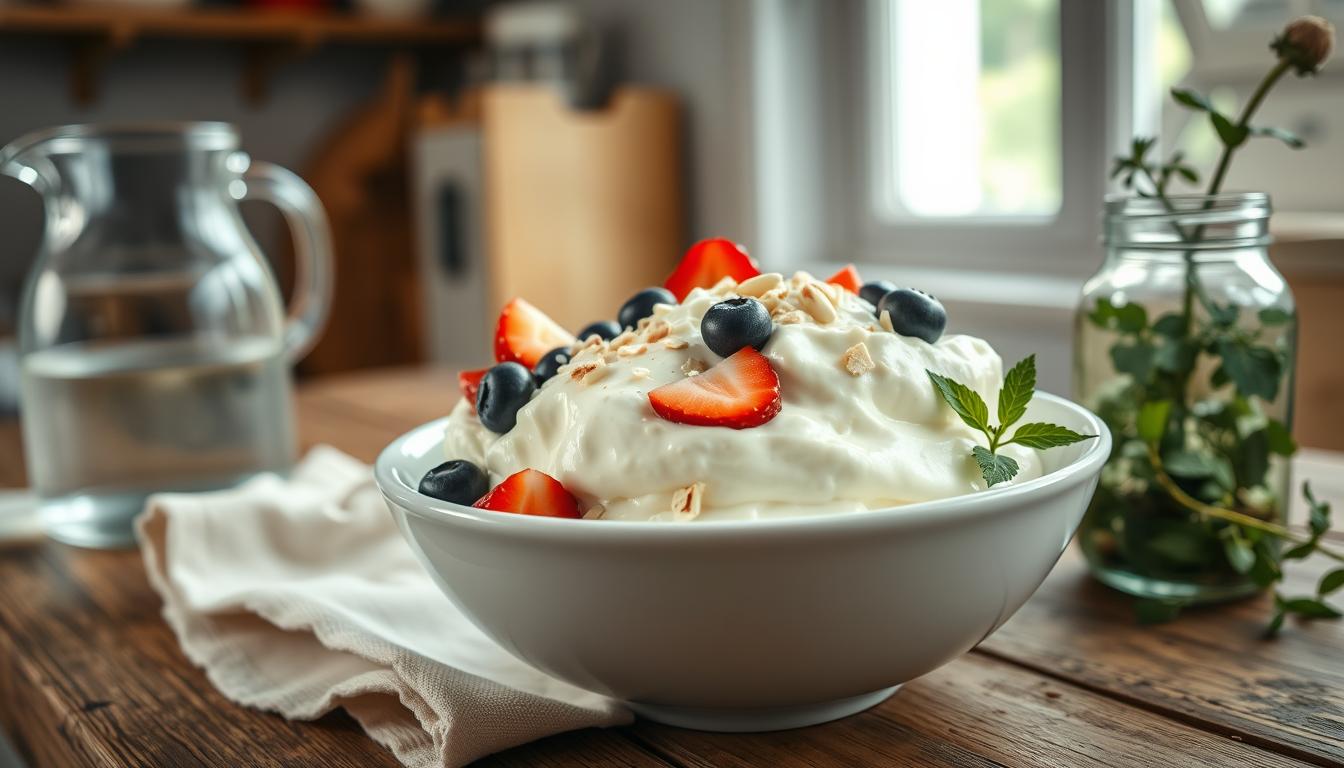Discover the magic of kabocha squash, the Japanese pumpkin that’s changing vegan Chinese food. Your journey into delicious chinese squash recipes kabocha vegan starts here. You’ll explore a world of flavor, nutrition, and plant-based innovation.
Kabocha squash adds a sweet and nutty taste to your kitchen. It turns traditional vegan chinese kabocha recipes into amazing dishes. With its smooth texture and versatile cooking, this winter squash opens up a world of tasty possibilities.
These squashes weigh between 2-4 pounds. They’re great for making authentic, nutritious dishes that will please your taste buds and nourish your body. From stir-fries to soups, kabocha squash gives a unique twist to classic Chinese plant-based cooking.
Table of Contents
Understanding Kabocha: The Japanese Pumpkin in Chinese Cuisine
Kabocha squash is a key ingredient in healthy Chinese squash dishes. It adds a unique flavor and lots of nutrients to vegan food. This Japanese pumpkin makes simple recipes into amazing dishes.

Nutritional Powerhouse of Kabocha
Kabocha squash is full of good stuff for your health:
- Only 30 calories per 100g
- Rich in vitamin C and beta-carotene
- Contains 1.1g protein per 100g
- Provides 1.2g dietary fiber
Selecting the Perfect Kabocha
When picking kabocha for your dishes, look for these:
| Selection Criteria | What to Look For |
|---|---|
| Color | Deep green or orange-green rind |
| Weight | Heavy for its size (2-3 pounds) |
| Surface | Firm exterior without soft spots |
| Skin | Dull, matte appearance |
Essential Preparation Techniques
To get the most out of kabocha, follow these steps:
- Wash the squash thoroughly
- Use a sharp knife to cut carefully
- Remove seeds with a spoon
- Consider leaving the nutrient-rich skin on for roasting
“Kabocha transforms simple ingredients into extraordinary meals with its rich, sweet flavor and incredible nutritional profile.” – Vegan Cuisine Expert
Knowing about kabocha’s special qualities helps make your dishes better. You’ll create tasty, healthy meals that everyone will love.
Mastering Essential Chinese Vegan Seasonings and Ingredients
Explore the world of vegan Chinese cuisine with squash. Learn the key seasonings that make your kabocha dishes special. Start your Chinese vegan meal prep with kabocha by knowing the basic ingredients for authentic flavors.

The heart of Chinese vegan cooking is its amazing seasonings. Make sure your pantry has these essential ingredients:
- Soy Sauce: The ultimate umami builder for vegan Chinese cuisine
- Fresh Ginger: Adds vibrant, warm undertones
- Garlic: Provides depth and aromatic complexity
- Sesame Oil: Brings nutty richness to your dishes
- Rice Vinegar: Balances flavors with subtle acidity
- Chinese Five-Spice Powder: Enhances kabocha’s natural sweetness
“Seasoning is the secret language of vegan Chinese cooking” – Chef Ming Tsai
When preparing kabocha squash, these ingredients work magic. The market for plant-based foods has reached $29.4 billion in 2023. Asian sauces saw a 25% sales increase. This shows vegan alternatives are getting more popular in traditional cuisines.
Your vegan Chinese meal prep with kabocha becomes more exciting when you understand how these seasonings interact. Kabocha’s nutritional profile, with 9 grams of carbohydrates and 1.5 grams of fiber per 100 grams, makes it a perfect canvas for these bold, traditional flavors.
Chinese Squash Recipes Kabocha Vegan
Kabocha squash adds a fun twist to traditional Chinese vegan dishes. It turns simple meals into amazing dishes that are both tasty and healthy. Exploring these recipes opens up a world of new cooking methods and flavors.
Traditional Cooking Methods
Traditional Chinese squash recipes use many cooking techniques. These highlight kabocha’s special texture and taste:
- Stir-frying at high heat for crispy exterior
- Steaming to preserve delicate nutritional profile
- Roasting at 400°F for 25-35 minutes
- Braising for rich, complex flavors
Regional Variations and Influences
Chinese regions have their own ways of cooking kabocha squash:
| Region | Cooking Style | Signature Flavor Profile |
|---|---|---|
| Sichuan | Spicy Stir-Fry | Bold, Fiery |
| Cantonese | Delicate Steaming | Subtle, Mild |
| Northeastern | Hearty Braising | Robust, Warming |
Seasonal Cooking Tips
Here are some tips to make the most of kabocha squash:
- Late Summer/Early Fall: Peak season for freshest squash
- Choose squash that feels heavy with shiny dark green skin
- Experiment with sweet and savory seasonings
- Adjust cooking time based on squash tenderness
“Kabocha squash transforms simple ingredients into extraordinary vegan meals that celebrate Chinese culinary traditions.”
Whether you’re a pro chef or a home cook, these techniques will improve your skills. They bring authentic flavors to your meals.
Perfect Stir-Fried Kabocha with Garlic and Ginger
Discover a vegan kabocha squash recipe that brings Chinese flavors to your kitchen. It combines kabocha’s sweetness with garlic and ginger. This makes for a simple yet impressive meal.
“The magic of stir-frying is about high heat and quick cooking that preserves the squash’s unique texture and flavor.” – Chinese Culinary Experts
Ingredients You’ll Need
- 1 medium kabocha squash (2-3 pounds), cubed
- 3 cloves garlic, minced
- 1 tablespoon fresh ginger, minced
- 2 tablespoons soy sauce (or tamari)
- 1 tablespoon rice vinegar
- 1 teaspoon sesame oil
- 1 tablespoon neutral cooking oil
Nutritional Powerhouse
| Nutrient | Benefit |
|---|---|
| Vitamin A | Supports eye health |
| Vitamin C | Boosts immune system |
| Potassium | Helps regulate blood pressure |
| Fiber | Aids digestion |
Start by heating your wok or large skillet over medium-high heat. Add the neutral cooking oil, then quickly sauté the minced garlic and ginger for about 30 seconds until fragrant. Toss in the cubed kabocha squash and stir-fry for 8-10 minutes, ensuring each piece gets deliciously caramelized.
The secret to this vegan kabocha squash recipe is maintaining high heat and constant movement. Drizzle in the soy sauce, rice vinegar, and sesame oil during the last few minutes of cooking. For an extra kick, sprinkle some optional chili flakes or a touch of maple syrup to customize the flavor profile.
Serving Suggestions
- Garnish with chopped green onions
- Sprinkle sesame seeds on top
- Serve over steamed rice
- Store leftovers in the refrigerator for up to 3 days
This tasty Chinese kabocha dish serves four and takes just 25 minutes to prepare. It’s perfect for quick weeknight dinners. Each serving contains approximately 150 calories and provides a nutritious, flavorful meal that will transport your taste buds to the heart of Chinese cuisine.
Miso-Glazed Roasted Kabocha Mastery
Learn to make a tasty vegan Chinese kabocha recipe. It turns this Japanese pumpkin into a dish to remember. Roasting it with a miso glaze makes simple ingredients into a feast for the senses.
Crafting the Perfect Miso Glaze
Start by making a great glaze for your kabocha squash. Your miso mix will be the main attraction in this vegan dish. Here’s what you need for a flavor that will wow you:
- White miso paste
- Rice vinegar
- Maple syrup
- Sesame oil
- Minced fresh garlic
Roasting Techniques for Ultimate Texture
Learn how to roast kabocha squash perfectly. Here are some tips for vegan Chinese kabocha recipes:
- Preheat oven to 400°F
- Cut kabocha into uniform wedges
- Brush generously with miso glaze
- Roast for 35-40 minutes
Serving and Presentation Inspiration
Make your dish stand out with creative garnishes and sides. These add to the rich, savory taste of roasted kabocha.
| Serving Suggestion | Flavor Profile | Nutritional Impact |
|---|---|---|
| Sprinkle with sesame seeds | Nutty undertones | Added protein |
| Garnish with green onions | Fresh, sharp accent | Vitamin boost |
| Drizzle extra miso glaze | Intensified umami | Enhanced flavor |
“Roasting kabocha transforms this humble squash into a culinary work of art”
This vegan Chinese kabocha recipe has just 161 calories per serving. It’s a healthy and tasty way to enjoy squash in plant-based cooking.
Creamy Kabocha Squash and Chinese Vegetable Soup
Find a cozy, healthy dish that turns kabocha squash into a rich, vegan soup. This recipe mixes old Chinese ways with new plant-based foods. It makes a meal that warms and feeds you well.
The soup highlights kabocha squash’s sweet taste, loved in Asian cooking. Roasting it boosts its sweetness, making a rich soup base.
Nutritional Powerhouse Ingredients
- 1 large kabocha squash (4 pounds)
- 3 cups low-sodium vegetable broth
- 13.5 ounces full-fat coconut milk
- Fresh ginger and garlic
- Aromatic Chinese spices
Nutrition Breakdown
| Nutrient | Amount per Serving |
|---|---|
| Calories | 469 kcal |
| Protein | 8g |
| Dietary Fiber | 11g |
| Vitamin A | 6214 IU |
Pro tip: Roast your kabocha squash at 400℉ for 30-35 minutes to unlock its deepest flavors before blending into the soup.
“A soup that warms the body and nourishes the soul” – Traditional Chinese Culinary Wisdom
Your creamy soup lasts up to 3 days in the fridge, great for meal prep. Top it with fresh herbs, coconut milk, or toasted pumpkin seeds for extra taste and nutrition.
Essential Kitchen Tools and Equipment for Kabocha Preparation
Preparing kabocha squash needs specific kitchen tools. These tools make your Chinese vegan meal prep easier and more efficient. The right equipment can make cooking fun and easy.
When you explore kabocha squash cooking methods, quality kitchen tools are key. The right utensils make your cooking journey smoother.
Must-Have Cooking Utensils
- Sharp heavy-duty chef’s knife (10-inch recommended)
- Large 12-inch wok or deep skillet
- Wooden or bamboo spatula
- Sturdy cutting board (preferably hinoki cypress for knife preservation)
- Small preparation bowls
Time-Saving Kitchen Gadgets
Make your Chinese vegan meal prep faster with these tools:
- Specialized vegetable peeler for tough kabocha skin
- Food processor with sharp blade attachments
- Long cooking chopsticks (approximately twice standard length)
- Digital kitchen scale for precise ingredient measurement
“The right tool makes every cooking task a pleasure, not a chore.”
With these tools, preparing kabocha squash will be more efficient and fun. Remember, quality tools are investments in your cooking skills.
Balancing Flavors in Vegan Chinese Kabocha Dishes
Mastering flavor balancing is key in vegan Chinese cuisine with squash. Kabocha squash’s sweet base can be enhanced into delicious dishes with the right seasonings.
Start by learning to complement kabocha’s natural sweetness. Important strategies include:
- Pairing sweet kabocha with umami-rich ingredients
- Adding depth with fermented seasonings
- Introducing contrasting flavors
Professional chefs suggest several ways to boost your squash-based dishes:
- Layer umami with white pepper and nutritional yeast
- Roast mushrooms for richer flavors
- Add salty elements like fermented black beans
| Flavor Component | Recommended Ingredients |
|---|---|
| Umami | Miso paste, roasted shiitake mushrooms |
| Salt | Tamari, fermented black beans |
| Acid | Rice vinegar, pickled vegetables |
“Balancing flavors is an art that transforms simple ingredients into extraordinary dishes.” – Vegan Chinese Culinary Institute
By grasping these principles, you’ll craft nuanced, delightful dishes. These will showcase the versatility of this amazing squash.
Expert Tips for Quick and Easy Kabocha Preparation
Learning how to cook kabocha squash can make your Chinese vegan meal prep easy and fun. This Japanese pumpkin might look hard, but with the right steps, you’ll get good at it fast.
- Microwave hack: Soften the squash for 2-3 minutes to make cutting easier
- Use a damp kitchen towel under your cutting board for maximum stability
- Always start by removing the stem end for safer cutting
- Keep the nutrient-rich skin on for added fiber and texture
For Chinese vegan meal prep with kabocha, consider these time-saving tips:
- Batch cook and freeze prepared kabocha in portioned containers
- Roast multiple squash at once to use throughout the week
- Dice and store in airtight containers for quick stir-fries
“Efficiency in the kitchen starts with smart preparation techniques.” – Vegan Cooking Wisdom
| Preparation Method | Time Saved | Best For |
|---|---|---|
| Microwaving | 5-7 minutes | Softening tough exterior |
| Batch Roasting | 30-45 minutes | Weekly meal planning |
| Pre-cutting | 15-20 minutes | Quick weeknight meals |
By using these kabocha squash cooking methods, you’ll make your Chinese vegan meal prep faster and healthier. You’ll enjoy tasty dishes with less effort.
Conclusion
Your journey into chinese squash recipes kabocha vegan has opened up a world of flavors. The kabocha, a Japanese pumpkin, is not just tasty. It’s also a bridge between old Chinese cooking and new vegan dishes. It’s low in calories but full of vitamins A and C.
Vegan chinese kabocha recipes show how versatile this squash is. You’ve learned to roast, stir-fry, or make creamy soups with it. Each way brings out its special texture and flavor. Plus, it’s full of beta-carotene and fiber, good for your health.
Adding garlic, ginger, and tamari to your dishes makes them taste great and fit your vegan diet. Exploring Chinese vegan cooking with kabocha squash shows healthy food can be tasty and culturally rich. It encourages you to keep trying new recipes.
Cooking is a never-ending learning process. Every recipe you try helps you get better at mixing flavors and techniques. Your kitchen is a place to create, and kabocha squash is your tool to make delicious, healthy meals.


